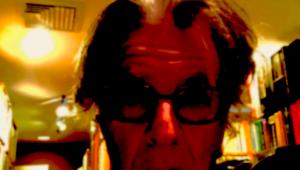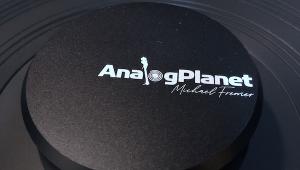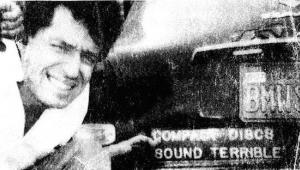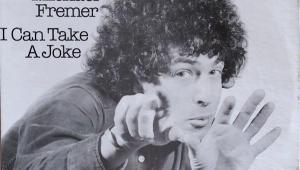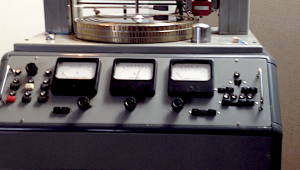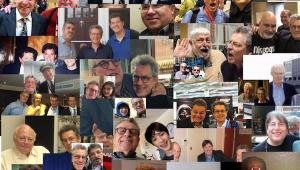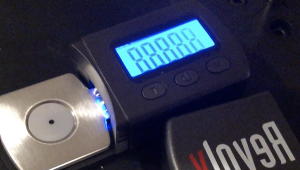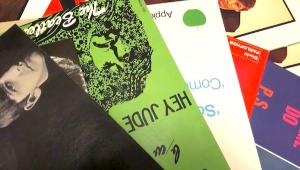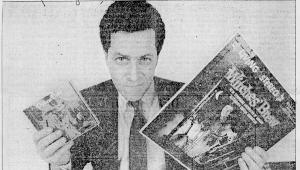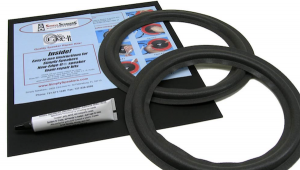Then I became an audio enthusiast and I got a job in the biz too! There's a lot of this stuff in the industry unfortunately. I know very intelligent people who are as deaf as a wall. They can't distinguish anything musical with their ears. They are the first to stomp their feet and scream everything Mike has quoted from Gizmodo in this article. They are often the first to say their systems are better than a live concert too. They usually say wires make no difference. They hate analog and look disdainfully at anyone who does. I'm friends with some of these people. What can you say to them? If you can't hear anything nothing you say will enable them to do so. So let them play their 25 year old CDPs over zip cord through cheap processors feeding old speaker technology.
Gizmodo Won't Post My Comment So I'm Posting It Here
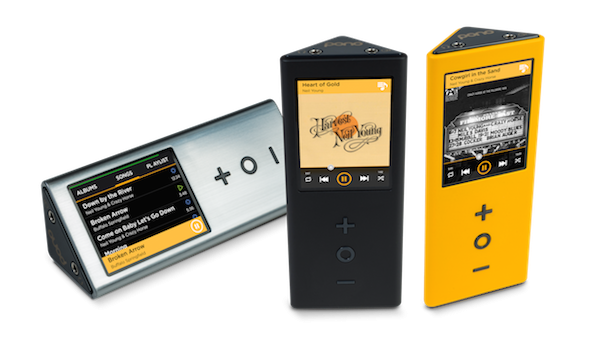
His second sentence is "You shouldn't buy it". In other words, he leads with his conclusion. What a putz.
But that's just for starters. He bases his heavy-handed conclusion on his limited knowledge and understanding of the subject and his reliance on a study by E. Brad Meyer and David Moran of The Boston Audio Society that's been thoroughly debunked.
Aguilar claims that both the study by Meyer and Moran and "math" prove that we cannot possibly hear the difference between 16 bit/44.1K sound and high resolution audio. He also claims that CD resolution was chosen based on "math" and science and that therefore its perfection cannot be challenged. Therefore, at best Neil Young is simply naive and being fooled by his own brain or he's a charlatan.
Aguilar embeds a clip of Tom Petty, Dave Grohl and others commenting after hearing a very convincing car demo Young put together. "Generous" to a fault, Aguilar writes he doesn't think these musicians are lying—they are just victims of "...confirmation bias, that natural impulse to hear or see what it is you want to hear or see..." when in fact "science and math" prove that CD sound is "perfect" and if you don't like it you don't like "perfection".
In other words, you don't know what you're hearing and can't trust your hearing because you are "prejudiced." It's a wonder we survived for tens of thousands of years using our senses not subject to A/B/X testing because only then could we know what we're actually hearing, seeing, smelling and touching. Is that a tiger behind you? Can't say until I perform that tiger A/B/X.
After reading this piece of phony scientific upchuck written by a know-nothing, I attempted to post something that I knew was over the top, but you know what? The reason audiophiles are held in esteem one step lower than pedophiles is because we lay back and take it (bad metaphor in that context but true). We need to fight back every time we read this crapola.
So I posted what I posted and awaited for moderator approval that never came. I emailed the editor of Gizmodo and he told me to wait because it takes time for the moderator to approve. But that never came.
Fortunately I had the foresight to do a screen save of what I tried to post. It took three screen saves to get it all so here they are. Yes, I called the guy an idiot. That's because he is an idiot. An idiot spewing mis-information and opinions that's he's wrapped incorrectly in science. He accuses Neil Young of "peddling junk science" but that is precisely what he does in his piece so here's what I attempted to post:
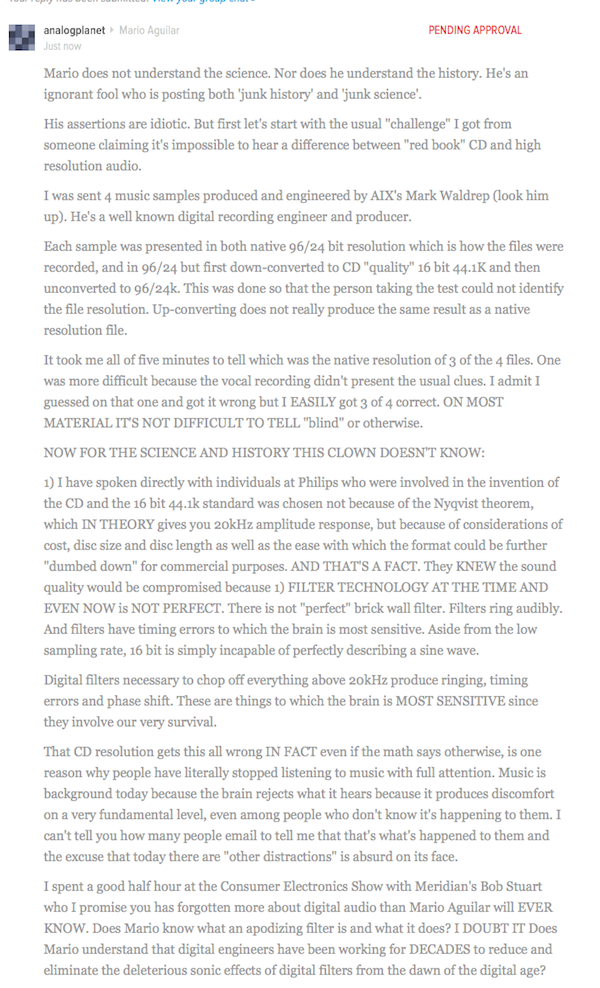
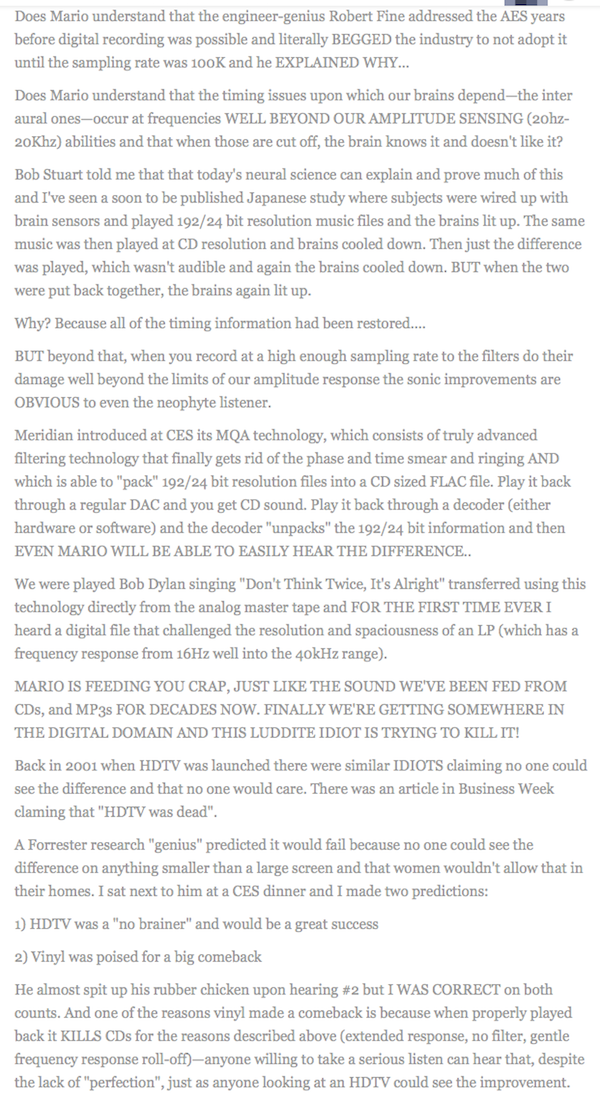
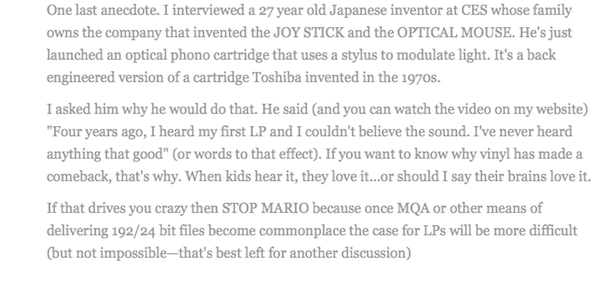
While I'm at it, let me tell you about E. Brad Meyer the "audio enthusiast" who co-published that aforementioned paper: some years ago I was invited by The Boston Audio Society to address the group about how the "TRON" soundtrack was produced. Brad, who always struck me as a very nice and decent fellow, gave me his address outside of Boston and I drove up there. Brad does not live in just a nice house or a McMansion. I'd say it's closer to a mansion with a cut stone circular driveway. The interior was filled with antiques and fine art. His wife told me to go out back where I'd find him either at the tennis court or the swimming pool.
After lunch we walked to the two story building on the property where Brad works and has his listening room, located on the second story in a Faraday cage (to reject RFI/EMI) and on springs (as I recall).
So here's what this wealthy "audio enthusiast" has for a system: a pair of Snell Type A speakers with subwoofers connected via heavy gauge lamp cord to a DBX preamp and DBX amplifier that Brad proudly said he'd bought at a bankruptcy sale. The build quality is similar to a NAD 3020—good for the price but cheap. For a digital source Brad had as I recall it, the original Sony CDP-101, which based on his measurements was "perfect" in the 1980s and still "perfect" today. He had his AR-XA turntable out for me, fitted with a Pickering XV15 cartridge.
He first played for me a Taj Mahal album. When I immediately said "Brad, that record is stereo but it's playing in mono, he responded "Good catch! I forgot I'd strapped the cartridge pins to play a mono record" (forgot probably because he'd not used the turntable in years).
The point I wish to make is that here's a very wealthy guy who claims to be an audio enthusiast yet his system is dated and thoroughly mediocre. Even if you believe if it measures "perfectly" it sounds perfect, in a home full of beautiful furnishings, artwork etc. wouldn't you also appreciate a finely crafted piece of audio gear and appreciate it even if just for how it looked and felt—even if you didn't believe it might provide a sonic improvement?
What is with appreciating the finer things in life except for the field in which you claim to be an enthusiast in which case you proudly own mostly junk and/or outdated or mediocre gear? What is wrong what that picture?
Does Brad listen wearing a hair suit? I don't get it. It's a condition of some kind that I don't understand but it goes a long way towards explaining why anyone would take the time and make the effort to "prove" that CD sound was indistinguishable from high resolution audio when the ears that we know and trust tell us it is so?
Why would you not exalt in finally being able to move beyond a 20kHz brick wall filter that rings, and produces time and phase smear that close to the audible band? Why would you not want to extend the response well past the limits of human hearing when you know that instruments produce harmonics and overtones that go well beyond the limits of human hearing and when you know that the timing information that we have relied upon for our very survival occurs at frequencies well beyond what our amplitude perception is? Why would you exert effort to stop the clock in 1982?
Let E. Brad Meyer and David Moran and the entire BAS live in the world of "CD perfection." Who cares? The problem is lemmings like Mario Aguilar use their mental pooper scoopers to pick up this stuff and spread it on the Internet. It's a big problem. We all have to fight this every chance we get.
- Log in or register to post comments


He not only leads with his conclusion, he makes his conclusion without even listening to the thing. I'm pretty sure the reason to purchase audio gear is to listen to it. At least that is why I do it. Maybe I am just mixed up.
I wonder why recording studios use such high bit rates if the lower bit rates Mario believes are perfectly fine will work instead. I guess they like to spend lots of money on analog to digital converters, high bit rate mixing boards and down sampling equipment. And more money to store the larger files and still more money to back them up. I guess every studio owner is a nutter, unless he (or she) records everything in Red Book. Hmmmm... How do those record companies even stay in business, constantly being ripped off by the greedy equipment vendors who keep selling them grossly over rated equipment? I think Mario should go talk some sense into those studio owners, lest the entire recording business implode from its own ignorance.

But here's a quote from one Robert Ludwig, you may have heard of him... from the current issue of Tape Op magazine, and apologies if I'm infringing:
" I think the higher resolution sounds reveal themselves not in A/B testing, but in long periods of time. Play an entire album in a relaxed atmosphere at 96 kHz/24-bit, then, at the end, listen to it at 44.1 kHz/16-bit, and you'll get it right away. A/B testing, while the only scientific method we have, does not reveal too much with short-term back-and-forth comparisons due to the anxiety the brain is under doing such a test. The brain becomes very left-brain-technical, rather than right-brain creative and musical. "

As long as the levels are matched and the listener does not know the identity of either A or B, the listener should be able to switch between them at will - as frequently, or infrequently, as desired. Listen as long as you like to either input, until any "anxiety" subsides. Problem solved. Now, what's Ludwig's next objection?

I was going to invoke a variant of Heisenberg.
But I did not post to make an argument, merely to relate something said by a man who has spent his entire lifetime not just critically listening, but striving to present the best possible sound, and who has an astonishing track record so doing. It is of no concern to me who may disagree with RL's statement. I know what I hear, I enjoy what I enjoy, and even on my pedestrian little systems I can hear quite well the improvement of higher resolution...

As stated above, listen as long as you like to either input and switch between them at will - as frequently, or infrequently, as desired. If switching only once is sufficient for you to make a determination (or not), that's fine. By the way, it was A/B, not A/B/X, testing that was mentioned.

You can devise whatever test you want. Choose the equipment, choose the music, choose the volume, choose how long you listen to it. If you can prove that you can reliably tell CD quality from high resolution, people will believe you!
When your argument is that you can "feel" the difference while ignoring any actual evidence, that's when you get lumped into a group with scientologists, homeopaths, ghost hunters and crystal healers.

...you don't agree with are automatically STUPID?
The outcome of the violin comparison doesn't mean that "all violins play and sound the same" - only, for that listening panel, the musician and the pair of instruments involved, a statistically significant distinction between the two of them could not be made. It's not a blanket statement covering all violins - or all listeners.

That whenever a test is verifiably false by your own experimentation, you should doubt the test and not your own experience. Karl Popper explained this. In order for a theory to be considered true, countless experiments have to confirm it but only one negative result makes it false. Assuming the experiment was not flawed and the result can be verified. A blind test has to be very carefully conducted with multiple groups and several times. Otherwise you may be testing the limitation of your experiment design. Do people prefer the last version they heard more often because it is fresher in their head? Do they prefer the first one because it was the first impression? For instance you may be testing memory and not preference.
Either way, your own preference should be important TO YOU. So if your own testing concluded you prefer analog sound then that solves the issue for you. Or do you go around forcing yourself to like things that A/B test positive regardless of your own experience?

What they don't tell ya these ABexers (and it is because they don't know) is that everyone will fail a blind test. It's a stacked deck. The only way to pass a blind test is to practice blind testing. Who the hell is going to do that? Blind teating has nothing to do with listening to audio... Zilch. It is like everything else the more you practice it the better you get. Hell you can even practice going to people houses sitting down and drinking their scotch and blind testing away.
Another thing that seems to evade the logic of blind testing. Everyone has biases, but what is never mentioned people can over-come these pyscholigical barriers. They think you sit in front of your same system for years and never get better at hearing it. They truly are ignorant at audio.

That's not reasonable to say that "everyone will fail a blind test".
If I give you a blind taste test of Dr. Pepper vs. Coke, you can't tell the difference?
Or, in the realm of audio, if I play you an ABX of a cassette tape, vs. a .flac file, you can't tell the difference?
Anyone who reads these comments would be able to ABX a 128 kbit/s from a 320 kbit/s mp3.
The real usefulness of ABX comes into play at the higher levels. To know when each individual person can no longer distinguish one kHz/bit level file or compression from another, and maybe you should stop spending money on components or storage space.

It may be unreasonable if we apply easy Blind Tests like soda pop, it may be easy for people to hear between low Mp3 bit rate to redbook too. But as you pointed out there is a scale of difficulty you have applied.
Blind Testing makes a suggestion that people have the ability to perform these tests outright. They do not, people will fail them. No one comes equiped to perform blind tests unless they train them selves to perform blind tests. If you are looking for the correct answer that can be derived from these tests that is your answer. When you scaled up the difficulty you have inadvertantly admitted that people either all come naturally equipped to do blind tests or (which is more likely) that they will have to practice doing these tests to pass them.
All the outcomes (that I've seen)suggest they need to practice blind testing to perform them. On anything actually.

It's lunacy to think your ears won't work properly unless you can see a thing or are "aware" of what you're listening to.

I', not sure I subscribe to this opinion, Michael - as much as I respect and enjoy your commentary…
While there may be differences between the Stadivarius, and the modern Cremona violin, that A/B test is useful to demonstrate two things that I have come to understand (using guitars as an analogy since I know little about violins):
1. A well built guitar made by a talented luthier, can and does sound every bit as good as a vintage Martin, Gretsch, Gibson or (insert your favourite here). It could very well sound alike to one of them but cost thousands less.
2. A 50 year guitar veteran once told me: "Tone is in the fingers".
That is, that in the hands of a talented player, an instrument can sound very much different than if it were played buy someone else. And two seemingly different instruments played buy the same player may approach similar tones by virtue of fingering, bowing, and the player's "touch". So a world class principal violinist could very well play the (admittedly very well made) Cremona violin to a similar tone to the Stradivarius.
And anyway there are more reasons than quality of sound that Stradivari cost in the seven figures. One is definitely the rarity and collectibility of the instrument, much like vintage Ferrarris that command similar prices.
Oh, and I fully agree with your commentary not he Pono player.

Can I get a big Amen from anyone who thinks the Bryston 7B is the best amp in the world. Smokes every including anything Musicall Fidelity can put out. Any body with a lousy History degree even knows that.

I used to play the violin to quite a high standard (around A. Mus A. here in Australia). Back in 1978, not long after our national classical music FM station - ABC FM - began broadcasting, they ran an extremely interesting one hour program where violinist Manoug Parikian played 4 violins - behind an acoustically transparent curtain in random order - to a small audience, amongst whom were none other than Isaac Stern and Pinchas Zukerman. The idea was that one violin was an ultra-expensive Strad, another a mega-expensive Del Gesu the third a much less valuable Vuillaume (which these days still cost around as much a three bedroom house!) and then the 4th was from a modern maker.
The idea was that the radio audience could also participate in this "blind test". Now I was listening to this test on a portable, battery powered, mono Sony FM radio with a 10 cm speaker. Suffice to say that I easily identified each of the 4 violins without any effort whatsoever. It was dead easy. Even with the portable radio. What floored me was not how easy I found it, but that neither Zuckerman nor Stern got them right!!!
In hindsight, however, individual violin sound is one of those very rare things where a recording is more revealing than actually being there. The sound engineer can mike the instrument "perfectly" and intimately, whereas in real life you have room distractions such as extraneous noise, whilst detail and timbre and certain frequencies are attenuated in the playing environment. Therefore, it is actually far harder to pick the real thing from a seat in a hall than it is a good recording. Still, in this casse, you could not have had three violins sound more different, as they were very stereotypical of their maker's sound. The modern violin was a dead giveaway because the player was struggling with response (though it did not sound that good either).

In such a test the listeners are instruments. Instruments to measure. The measured variable is nominal scaled. That means, the listener has to identify violin A or Violin Not A. If the listeners are not calibrated, their vote cannot be referred as a "result". It' s their opinion. Calibrating people consists of teaching them to discriminate violins. Let them listen til they are able to distinguish Violin A from violin Not A in 10/10 cases. Or in 100/100. Finally they are able to tell, whether they hear violin A or violin Not A. If the "Instruments" are supposed to identify ViolinA, B, C ....the calibrating process will last much longer and will be much more expensive. If we want to make decisions on a scientific base....so it goes.

To match (sort of) Mr. Ludwig, I've been telling anyone who will listen relating to DACs, "You may not hear a difference right away. Just listen for awhile. Then disconnect the DAC and then you will notice the difference."

Senerdipity - Yesterday a friend was telling me again how you don't need any more than 44/16 for perfect sound and the digital issues were only related to filters recomposing the signal.
I still struggle with this from a pragmatic view (and this is where I guess I really need to understand what is going on). At a instantaneous point in time music is a complex mix of sine waves of different frequencies and amplitudes with different node points. The frequencies then are changing all the time and that it is the differences as they change that we ulimately hear as music - and if this is right how the **** can sampling at a rate of 44khz adequately capture the changing sine waves of higher frequencies to enable its re-creation perfectly e.g. 4 points on a graph at 11khz? surely it is best guess?
And yes I am sure there is much we don't know about how we hear - do you take your glasses off when you listen? and if so what happens? maybe there is something about the pressure changes on your eye area? and this is just the start.

Eventually it's got to come out. i know Harmon don't make TTs so there aint going to be much said about this over at the AES. The last thing they want are bobble headed naysayers to know Vinyl is the final frontier.
The goal on every dac is to output a full analogue sine-wave. Guess what 16 bit doesn't. In fact it so quasi digtal that a filter is needed to make the output look analogue. 24 bit more analogue but not quite. Hold on! What medium out puts full analogue? Come one you know... Vinyl!!!
And thus lays down the formula that is best descibed as True Hi-Res... Vinyl. Eat that Harmon.

Part of the problem is that life doesn't happen in sine waves. Also, all the various waves are summed/superimposed by the time the signal is mastered for each channel giving only a single voltage per channel. Matching sine waves (per the reconstruction algorithms) to accelerations for transients to closely track them would require stratospheric sampling rates - well, the high-res sampling rates we have.
But back to the sine wave thing - if all you listen to is reproducible as sine waves, that must be pretty boring. Rock and roll happens with some good squarish waves here and there. Triangle and sawtooth waves make for fun brainscrews. Filling in the blanks with dithering is inherently wrong. Most who have looked have found CDs that sound better than some LPs, but the best of each has LPs on top. I haven't heard high-res digital on nearly as good a setup as vinyl and cd, so I must refrain from judging based on a vain attempt at being a reasonable human.

Much of the internet contains this kind of "content" - it is only there to draw people to the ads (and links to other articles with more ads), which is the goal of most websites (and how they make their money).
I recently read a concert review in Rolling Stone by someone who couldn't tell one musical instrument from another. He was both ignorant of music and of the performer. That was an eye-opener for me.
The average age of the Gizmodo staff appears to be about 28 – great for relating to most of the readership, but not so great when experience & knowledge are needed.

Seems like envy to me. People who enjoy cars and automotive design spend as much bank as they can afford on a car, and people who enjoy cooking spend more than my stereo's cost on a stove range. Musicians seek out the qualities of rate instruments like Stradivarius and sometimes spend more than the cost of Mike's turntable on a bow. Are they idiots too? Are all people's intelligences measured by your own spending choices? The argument is particularly ridiculous when thrown at a professional audio reviewer, no? Time spent with anything leads to sophistication and sophistication leads to the need for more refined tools.

...that bad, that good, that what?
The cynic would suggest that a manufacturer, the success of whose business can depend upon receiving positive reviews, might tend to flatter a reviewer and his system.

To coin a phrase. It's clear to me that I, at least, need to listen to/hear a system over a certain amount of time to ascertain whether I can comfortably live with it - in other words, listen to it for hours at a time without a headache. That may sound like I don't care about "accuracy," but it is the bottom line, or one of them. Another is whether said system demands that I listen to it rather than doing something else simultaneously. For me over the last thirty years that has meant vinyl through vacuum tubes. Can't measure that, brah.

I talked with him at RMAF. He comes off as rude, but he is just blunt. The guy is brutally honest and has no one to impress.

I enjoy 100 times more than having a super expensive car parked on the street to weathering like many of my neighbours... for example. Who is the stupid here? So I could ask If cars ads over 200.000.$ should be banned? Enjoyment is relative. A very few things in life is comparable for my than a listening session of my favourite music in a great system.
Mikel, all my support for your work. In Spain we said : " No está hecha la miel para la boca del asno" something like " the honey isn't for the donkey"
Sorry for my poor english.

...I would actually say that it is well reasoned to have a system, including such a turntable, that helps him the most when testing new gear. This enables him to test some of the best gear, that wouldn't be tested fairly otherwise.
You can easily test a car, because it is tested as a whole. But if you had to put your own korean tires on an Audi, riding it on a dirt road... Now that wouldn't be fair either.




And I wanted to comment against its basic assumptions... But a quick scan through the posted comments showed me all of them were in favor. I foresaw the gang attack I was going to get for being a dissenter and backed off. Now I wonder if all those comments in favor actually represent the readership or if they have been censoring dissent.
The funny thing about these types of arguments is that the writer never seems to have tried the thing he is arguing against. I have held arguments about interconnects with people who are convinced they are snake oil, but invariably they either have never actually tried them on their system or their system is so low-fi that it would not be able to resolve any cable gains.
It is hard to argue with an argument that starts by affirming that all those against are crazy or deluded. But this is clearly not scientific as proposed by Karl Popper. Any statement that does not allow falsifiability -- it does not allow the possibility of it being proven false by experimentation -- is inherently unscientific.

It is sadly ironic that a fellow with no technical or experiential knowledge would play the science an know-better card. Understanding the inadequacy of the science is a complex matter that has fooled many engineers, let alone nincompoops. Like many know-nothings, he simply knows better and proved us all dummies. Where's Randi with his cash?

"It took me all of five minutes to tell which was the native resolution of 3 of the 4 files..."
That says more than anything else you or he said overall.
The sad truth though, MOST audiophiles, are not even remotely "aware" of how their other senses, perception, biases and emotions factor into their assessment of audio products.
Michael, you routinely promote vinyl records as the be all end all of sound reproduction,but conveniently somehow are unable to not ascertain relatively audible amounts of distortion, Inner groove distortion, nor changes in high frequency phase and level, that change from outer to inner grooves.
Relatively audible things, but because of your bias towards vinyl, you seem "immune" to hearing them.

Pono reminds me of 1994 and Cory Greenberg of Stereophile who wrote that a radio shack player and a pair of Grado SR-60's was the end all. I still have that player and today it sounds like shit. I thought Neil was going to manufacture little metal masters which would be played back with a laser stylus (sounds crazy, I know.)

CG never said that. He loved the SR60 but thought the RatShack player was very mediocre. You are probably thinking Sam Tellig.

Many find the shortcomings, audible though. I said nothing about "Measured" shortcomings. It comes down to mostly preference, emotions, and what "appeals" to certain individuals.
Not everyone is looking for the "Best sound", but more appropriately, what "They like best". Different things for sure.
I can not explain anyone's preferences as I have no idea what is in their minds.
Remember though, some individuals are more attuned to hearing certain flaws in vinyl, while others simply are hearing mostly the positives.
In audio, as in many things, there are no "certains", and nothing is final or concrete.

If vinyl proponents were more honest about it, like you are, then they wouldn't be laughed at. Not that they all care about being laughed at, but a lot of them do, judging by how defensive they are. I am fairly confident that I could make a digital rip of a vinyl record, and if played back over the same system that is playing the vinyl, it would be indistinguishable because it would have the same hisses, pops and pitch variation.
So while I recognize vinyl isn't superior to digital, I still like listening to it. The ritual of dropping the needle on the record, getting up to flip it over, having that physical item in your hand that has the music literally etched into it, makes it an experience. I fully acknowledge that it's not a truer representation of the original recording, but I can still enjoy it. Being a skeptic and a vinyl lover are not mutually exclusive.

The reason is they've learned to sit down in front of their gear and enjoy. Playing music and listening to music on stereo are entirely different from each other. There appears to be a fog that exists here. Like playing music makes you defacto audiophile. No it doesn't, neither does complaining about wires, hi res or (all amps sound the same crap). The same enjoyment can come from building a file based dac playback system too. Its all about the sweet spot.

I don't hear any speed instability. Of course I'm using one of those nasty dark sounding SL-1200s. Or maybe the other identical one. But seriously folks, that's not a problem even with my bottom feeder NAD 533. Or even the ancient Garrard changer. Try another canard.

Funny Michael mentions right off in his article master tape being the ultimate source. Actually live unamplified music, but I'd garner he spends a lot of time attending a variety of concerts and appreciates his system at home all the more for how limited its short comings are.
An analog signal via turntable done right may have limitations in the medium but they can be adressed and minimized. Sampling that waveform, forget it. The nuance of a bowed string instrument is too complicated to be sampled without affecting it's character.
The mantra "enjoy music, tolerate equipment" rings true, and the analog medium, addressed correctly becomes more enjoyment and less toleration
I am grateful to Michael for sharing his experiences. Perhaps he could be a little more civil with the less informed, but it is refreshing to read about him addressing the misrepresented issues with a passion. That same passion that we get from being elevated by music

Lincoln Center was built WITH the science of acoustics. What can I say?

You obviously do not read much of Michael's stuff if you really think that. I have forgotten how many of his article actually address those factors, but over the years I have seen him mention them many many times.
Or are you just Trolling?
Good listening,
Z

Michael--I recently decided to unplug from digital, as I'd suffered, exactly as you've seen so many times, but total music apathy. It was my brain all along! It's heretical in my work to say this, since I work for the big fruit company, but I've never felt so engaged with my music since I went vinyl over Christmas. Thank you for the great blog!

Taking the opportunity to post something off topic:
Isn't it cool, in the internet age we get to have critical debunking taking place in the public sphere, rather than having half-baked rumor and prejudiced guesswork continuing to live on thru the grapevine.
Rather than a concensus arising because the self-proclaimed authority at work or at school or audio-salon has had his say, we get much bigger-tent sources that we can verify and factcheck at will.
Also I'd like to point out that it's cool to hear helpful debunking of Digital hearsay taking place within the confines of -- and with the blessing of-- a dedicated Analog page. With Analog enthusiasts trying to get to the bottom of what is entirely a digital topic offers a glimpse into the working of audiophilism when done correctly.
Yay, us.

was first presented by Dr. John Diamond, MD at an AES conference in 1980. He noticed that vinyl and tapes sourced from digital masters didn't have the same healing power as music once had for mental health patients. For more information, see the book Perfecting Sound Forever: An Aural History of Recorded Music by Greg Milner, page 207-8. The issue of using low sampling rates is not new.

If you have both the vinyl and cd versions of an album get them out and set them up ready to play. Try as best you can to match levels. Sit back and turn both up to room filling volume. See what your ears tell you. I tried that recently with the analogue production release of Bayou Country by Creedence Clearwater and the 2008 cd reissue. The vinyl version was enjoyable at that level while I just wanted to turn the cd back down. It was some irritating edginess to it. But try it for yourself and see what you find.

Whenever I play a CD my wife will ask me to please turn it down from the other room. It never fails, even though she does not know I am playing a CD. She is not into the details, but she enjoys vinyl tons more and has become CD-intolerant.
But to be fair, since CD and LP are being played through different systems of different qualities, this is a tough sale as a good test. I guess a better test would be an AAA LP vs a 16/44 digital remaster LP of the same material. Has anyone ever done that?

I agree. The playing field does need to be level. It wouldn't be fair to put a $500 Marantz up against something like a VPI. My setups are more evenly matched, I believe. I have a Rega P324 with a Dynavector 10x5. My cd player is a Cary cdp1 going into a Rega dac.

My ex-wife would know from the other room if an LP or CD was playing.
She once told me, proud me with a new LP from a certain company, that "That's crap. It's digital". With me thinking it was an analogue LP. I checked. And she was right.
She refused to have CDs playing when I was in the house, her comment "with you around, why should I listen to that crap?"

Sunderwood, I'm a huge huge vinyl fan, in fact I run an internet radio station that plays 100% vinyl called True Vinyl Alternative. I spend more on my record cleaning machine than most people spend on hi-fi in a lifetime. I record my vinyl to hi-res (24/96). To me vinyl is the ultimate format.
That said, I strongly suspect that the huge difference you are hearing here -- and it is huge -- not subtle -- is the mastering. I looked up Bayou Country in the dynamic range database and the 2008 CD was significantly lower in dynamic range, i.e., it was squashed like everything released in 2008 (one of the worst years ever). I found the other Hoffman mastered Analogue Productions CCR vinyl titles and both the vinyl and CDs measured excellent in terms of dynamic range.
To find this information do this search in google "dynamic range database bayou country"
Audiophiles are hyper-focused on resolution in my opinion because they are often already dealing with the great source material as a starting point. The "average Joe" is not.
In my opinion, what is "better" in terms of mastering is subjective -- my kids don't get easily annoyed by the hyper compressed sound -- but I do! You may be a person like me (there are many) who really, really, really dislike the sound of over-compression. It's been rampant with CDs and digital downloads since 2000, it is far less common with vinyl. Which is one reason, not the only reason, why I love vinyl so much.
Try this test -- if you can record your vinyl go ahead and record it at high resolution if you can, then convert it to 320kbps mp3. If you still prefer this version to the CD then the issue is mainly mastering differences and not "resolution" differences. I'd be really surprised if you did not prefer the 320 mp3 of the vinyl to the 2008 CD.
Next, if you have an audio editor, take a look at those waveforms, which one looks like some artificial process squished the waveform? Which one ebbs and flows like something more natural?
I use a software called AudioLeak to measure the dynamic range myself while visually look at the waveforms, a squashed waveform is an obvious thing.
Why would I do this? I've learned over the years something important about MY tastes -- I despise unnatural over compression of the 2000s. I just do -- so I tend to focus on this as a driving factor. For MY tastes this is a much bigger driver of my satisfaction with music than the resolution.
I do this process all the time. You can see some of these pictures / measures / thoughts on my Twitter account if you are interested @TrueVinyl.
If you are like me, you might learn that you are also sensitive to this particular factor (dynamic range) and you may want to check the database before you dump any money into any CDs or even vinyl in the future.
You might also learn, like me, that you think Steve Hoffman is a guy who is OUTSTANDING at his job. I've dumped some might $ on Hoffman remastered vinyl. You might also check out CDs and LPs done by Mobile Fidelity -- again, I'm guessing you may be like me and prefer a natural dynamic sound which they specialize in. Just remember to turn it up.

Note that the term Dynamic Range is an overloaded term in the audio world. In the context of my comment and the use of the term in the "Dynamic Range Database" it refers to the difference between the average and peak levels of a recording.

I had said that the copy of Bayou Country that I have is by Analogue Productions. It is actually the 180 gram version. The rest of my Creedence albums are Analogue Production. They all sound very good to me. I bought them last fall when I was in a record store and found Bayou Country for $20. I had never been that happy with the sound of the cd versions I bought. When I got home I set both versions up to compare and experienced what I mentioned in my original posting. At that point I had to get the rest, except for Mardi Gras which I don't like that much other than a couple of songs. I do have a couple of Mobile Fidelity records, Santana 3 and Foreigner 4. They have very nice sound. Some would balk at $30 for a record, but you get what you pay for. Thanks for your reply. Very interesting.

Thanks Sunderland --feel free to contact me if you want to discuss any of this stuff further or the tools I use, it's my hunch that we have similar "ears" of what sounds good:
truevinylradio @ gmail . com

I can't remember exactly where I read this, but if I had to guess, it was the section of the book "Appetite for Self-Destruction" that dealt with the CD standard. But anyway, my understanding is that a big reason for the choice of 16/44, or at least the 44.1 kHz sampling rate, was that it was the rate most compatible with using broadcast quality analog videotape as the storage medium for master digital recordings. Anyone (Michael?) know more about this?
Also, with the SACD study mentioned, wasn't there an issue there where a majority of the SACDs tested were upsampled CDs (or CD quality recordings) and not new transfers?

I was just having this conversation with a friend the other day. He came over to listen to vinyl, since I had been pestering him for weeks. I have been fine-tuning my new turntable rig for months and felt it was ready to impress. (VPI Classic 3 + 3D tonearm, Cadenza Black, VPI Synchronous Drive System, Sutherland Engineering 20/20 photo stage). My friend used to listen to CDs and lately music has become a hassle and he only listens to Spotify in the background. He likes Ella Fitzgerald so I played AP Ella & Louis. The look on his face as Ella's voice came out of the loudspeakers was priceless. He was in shock. Then he was ecstatic, he could not believe it and he wanted more. We played music for a while and then I switched to the same music on Spotify, through a very good DAC. The face of disappointment was immediate.
Afterwards we had this conversation, and this was my point. Vinyl is much more inconvenient to play than CDs and even more so than streamed music. But everyday I am looking forward to the hassle of listening to vinyl. I am engaged and I enjoy the music even though every 20 minutes or so (less for 45rpms) I have to get up, remove a record, put it away, take out another, put a ring clamp if the record is warped, brush it, brush the stylus, etc. The records must be cleaned when purchased, even if new. More space is required, and every few weeks my SMARTractor, Fozgometer, and scale are taken out and the whole thing tuned up.
All of that vs. click play on a Spotify playlist. It's crazy, really. Some have told me, it's an object fetish and, for sure, I do enjoy my turntable as an object and I do feel more physically connected to music when I can actually relate musical phrase to place on the record and I can see a precision machine physically moving and touching that place. But that is not enough. I was afraid when I decided to go back to vinyl from CDs at my father's insistence, that it was a fad and it would wear off. But here I am, a year later even more excited than the first day.
Every week I look forward to new AAA releases. I scavenge eBay and Discogs for old pressings. I am looking for storage space so I can put away all the CDs and make room for more vinyl. Music is back in my life. If there is a fetish is music itself.
The shortcomings? The better the system, the finer the tuning, the less noticeable they are and clearly the less of an obstacle they become to the enjoyment of music. When asked about clicks and pops my father used to tell me, well, they are not that common, and they are less bothersome than you would think. He was right, an occasional static pop is not a problem, specially when compared to all the hassles of live music, the standard.
And who says CDs are without their issues in this respect. There are CDs that won't play. That has yet to happen to me on an LP. CDs that skip for no apparent reason. On LPs I can always see the reason and most times correct it. CDs get scratched easier than records and are more sensitive to those scratches. I have bought LPs that looked awful and after a thorough cleaning sounded like brand new. I have had dozens of 1980's DG CDs fade as in they become almost transparent and stop working. You have to really overplay a record with a cheap stylus on an out of tune table to damage a record--like a couple I purchased from library sales. Jewel cases are a real nuisance and at my age, unreadable. LP covers are art and contain tons more useful information.

Conspicuously absent from the Gizmodo article, and most discussions of consumer hi-res audio, is a discussion of the importance of sample word length, a.k.a. bit depth. The effect of bit depth is much more audible than that of the sample rate, because it is not influenced by the design of the low-pass filters in the DAC; the difference is clearly audible on an iPhone, or any device capable of playing back 24-bit audio. Mario neglects to mention this, or that 24-bit audio divides the dynamic range, from dead silence to clipping, into 16,777,216 discrete values, compared to 65,536 values for 16-bit. The result is less quantization distortion, and a lower noise floor, typically around -113 to -117 dB below full-scale (i.e. clipping) vs. 90 - 96 dB for 16-bit.
Another important consideration is that 16-bit isn't really 16-bit. Combining digital audio streams in the mixing process requires sufficient headroom, to prevent clipping. This can be achieved either by truncating the least significant bit(s), and increasing quantization distortion, or by performing bit-shifting operations on the source audio. Either option eats up at least one bit of the affected sample word. This is why music is recorded at 24 bits per sample: to diminish the adverse effects (and audibility) of this process.

on the music. If you look at the DR Database you'll find few recordings that have more than 17 dB of dynamic range. I think for that reason, the sampling rate is more important. The bit depth of the product delivered to the consumer could be 12 bits and few people would notice. For production work, 24 bits is pretty much the standard these days, before mixing and mastering compress the life out of the recording (12 bits).

I think there is a widespread misunderstanding about the meaning of the figures in the DR database. The numbers are said to represent the difference between the average and peak levels of a particular recording. This does not mean that there are no signals below the average; in fact by mathematical definition, 50% of the time the total signal amplitude is less than average. And this says nothing about the composition of the signal at any given moment (nor can it.) At any instant there may be innumerable intricacies of sound far below that. The constantly changing harmonics of a string instrument, the decay of a cymbal, the last vestige of room reverberation... in the physical world these do not recognize any limits of human hearing, but may exist at levels below any possibility of perception. For many of us these nuances give recorded music life, a sense of space, palpable realism when present.
But I agree with you completely about the loudness wars and the effect of bad mastering to maximize volume. It's just silly and there's no way to recover the music as it should be after that is done.

mmarston beat me to the punch, and is essentially correct. The numbers in the DR Database indicate the ratio between peak and average levels, not the highest peak and the noise floor. Hyper-compression concentrates levels toward the upper end of the dynamic range.
12-bit audio was quite common in the 1980s, when many sample-based synthesizers first came to the musical instruments market. With 4,096 values between silence and clipping and 72 dB of possible dynamic range, few people would not notice the difference.

You mention comparing 16 and 24 bit through an iPhone. Problem is all but the brand new iPhones only have 16/48 DACs in them. The new ones have 24 bits but the operating system always down converts to 16 bit when playing through the built in DACs.

I know Mr. Fremer is always correct, especially with his own blog, but all the reasoning behind this CAPITALIZED tirade is rooted in pseudo-science.
The “pseudoscientific method”
To identify pseudoscience, there are six reliable clues that shout out “pseudoscience.” Almost always, you can find all six in any pseudoscientific claim.
-Extreme reliance on confirmation rather than refutation. Pseudoscience relies upon assertions that do not allow the logical possibility that they can be shown to be false by observation or physical experiment, a concept called falsifiability. In other words, real science assumes that there could be an experiment designed that would refute (or nullify) the hypothesis. Pseudoscience also asserts claims of predictability when it has not been shown to be predictive; “scientific” claims that do not confer any predictive power are considered at best “conjectures”, or at worst “pseudoscience”. Pseudoscience also maintains that claims which have not been proven false must be true, and vice versa, which also known as the Argument from Ignorance. Pseudoscience is also over reliant on testimonial, anecdotal evidence, or personal experience. Yes, this type of evidence can be used as observations to develop a hypothesis. But they cannot be used to test the hypothesis itself. Pseudoscience also overuses confirmation and selection bias in the presentation of data that seems to support its claims, in the meantime, suppressing or refusing to consider data that conflict with its claims. In real science, the burden of proof rests on those making a claim, not on the critic. Pseudoscience employs the reversed burden of proof, demanding that skeptics demonstrate beyond a reasonable doubt that a claim, for example, that some supplement prevents cancer, is false. It is essentially impossible to prove a universal negative, so this tactic incorrectly places the burden of proof on the skeptic rather than the claimant. Finally, pseudoscience appeals to holism as opposed to reductionism: proponents of pseudoscientific claims, especially in alternative medicine, homeopathy, naturopathy and mental health, often resort to the “mantra of holism” to dismiss negative findings.
-Lack of openness to testing by other experts. Pseudoscience researchers evade peer review before publicizing results, occasionally using press conferences to share their ideas. These “researchers” will claim that their ideas contradict the scientific consensus, so they must avoid the peer review process because that process is biased towards the established paradigms and consensus. They will also claim that their results cannot arrive from the scientific method. Thus, they get to avoid the feedback of informed colleagues. They will also appeal to the need for secrecy or proprietary knowledge when an independent review of data or methodology is requested. Of course, many agencies and institutions that fund real science research require authors to share data so it may be evaluated independently.
-Personalization of issues. Pseudoscience is often composed of closely tied social groups, and usually includes an authoritarian personality, suppression of dissent, and groupthink. This social construct can enhance the adoption of beliefs that have no rational basis. In an attempt to confirm their beliefs, the group tends to identify their critics as enemies. They also make assertions of claims of a conspiracy on the part of the scientific community to suppress results that support the pseudoscience. Finally, they attack the motives or character of anyone who questions the claims, the Argumentum Ad Hominem. As an example, the anti-vaccine crowd has invented numerous claims about Dr. Paul Offit, one of the great researchers in vaccines, just to attack him personally. They’ve done the same with Bill Gates.
-Use of misleading language. They try to create scientific-sounding terms to add weight to claims and persuade non-experts to believe statements that may be false or meaningless; for example, a long-standing hoax refers to water by the rarely used formal name “dihydrogen monoxide” and describes it as the main constituent in most poisonous solutions to show how easily the general public can be misled. More often, pseudoscientists use established technical terms in idiosyncratic ways, thereby demonstrating unfamiliarity with mainstream work in the discipline.
http://www.skepticalraptor.com/skepticalraptorblog.php/pseudoscience-fool/

And I do not think there has been any claims of science but on the side being criticized. But most importantly, making an unscientific argument does not imply the claim is false. It only means the argument used is not scientific. Though Michael's being able to identify 3 of 4 files is statistically significant.

What the hell are you talking about?

Mr. Fremer, you, yet again, mistake anecdotes and personal observations as fact. You're an evolutionary denier in a world of scientific, observable, repeatable, statistical evidence.
If you ever took a controlled listening test trying to identify a 16 bit recording (or even 320mbps MP3) from a 24 bit recording, your credibility would improve... slightly.

That one does not count right? 75% accuracy is not statistically significant anyways.

I actually joined analogplanet just to write this.
Name calling is bad journalism, Mr. Fermer.
You don't need to prove your listening abilities to anyone, but you as a journalist should prove your professional level to everyone, a thing that I didn't see on that massive comment for Gizmodo and in this one.
Best wishes on your future articles and best of luck for your endeavours.

Thank you for your reply Mr. Fremer.
I didn't had the "pleasure" of watching/hearing the those live TV versions yet, mostly because they don't fall under my viewing tastes, plus I live in Europe.
I know you are doing this for a long time and may you continue doing it for even longer but sometimes the readers must give some negative feedback (electronics pun intended). I don't agree with any type of name calling in articles from a professional journalist. Gizmodo for me it's like some British tabloids, it rides the wave of hype, but thats another story with a lot of name calling and curse words. Again my best wishes.


There is a lot of hatin going on about the Pono player and Neil Young. A lot of people just do not think that a Rock'n'Roller can be a good audiophile. Or help lead people to good sound. This guy at Gizmodo seems to have this condition. What's his name (Steve G) over at CNET does not like Pono very much either. I think that those people just do not want good audio taking the places of their MP3's on their phones.

Pretty much says it all. You gotta go down and corner him in his house to find out what kind of gear they got. These guys will never tell what they are running. They only tell you what you can or can not hear. Or what ever dumb thing electricity in their head finds a path out their mouth to spew. It almost robotic in nature and totally predictable. They never get better at it either.

This is a great write up you made Michael...
As to ABX. Let me tell you why I feel it s not as objective as supporters of t may feel. I'm not scientist nor doctor/audiologist. I just will write up about an experience I had a while back playing music through a variety of CD players.
I had an older Sony CDP-401 with Burr Brown PCM56 DAC's inside. I had at hand a Sony PS/2 and my Oppo BDP-83 Universal Player which has TOTL Crystal DAC's inside. Well I took a CD from the Bruce Cockburn, Slice O' Life album. A nicely recorded live album of Bruce in solo with his various guitars. What I found, I did not expect a s I did so.
1: I cue'd up the first track "World Of Wonders" in my BDP-83 and played it for 2 minutes. I made notes of what heard and how I liked the sound.
2: I then took the same disc, put in in the Sony CDP-401(?) and played (I level balanced as close as I could) the first track. Immediately could tell that it sounded different and not as good, as in the Oppo BDP-83. It was drier, less textured, less air. No it was not awful and such but easily noticeable to the difference between it and the BDP-83.
3: I then took the disc and put it a Sony PS/2. It also sounded not as good as the BDP-83. It sounded similar to the CDP-401. It was again drier, less airy and textured.
Each test ran for 2 minutes.
It was easily revealing that my Oppo BDP-83 was the best player of the three. BUT HERE IS THE INTERESTING THING!
I ran the test again. Starting with the BDP-83 again. I observed the sound, but noted that it did not sound as different this time, Hmm ??? I then ran the CD into the CDP-401 and noticed that was harder to hear the difference between it and the BDP-83 this time. I had to real concentrate to note a sound difference, where as the first tie it was easy to hear such, Hmmm Again ??? I plopped the CD into the PS/2 and again I could not hear any difference between it and the CDP-401. Not as much a surprise as in the first go round they sounded rather close to each other.
Again the same song, for 2 minutes only and as close to level matching as I could.
I ran the test for a third time and this time I could NOT tell any difference between any of the machines. This perturbed me, why can I not tell the audio difference between each any more?
I thought about this and my conclusion is this. Because each sample was the same track, payed quickly one right after another, the first go round showed the biggest sonic difference as to my brain each was a new play. But the next go round running the same song for the sane length quickly after each machine I think my brain just got lazy on perceptions. Its short term memory subconsciously was strong enough to process the audio tracks as being more the same as again it was the same track, for the same length of time and quickly swapping between players (not a true AB or ABX) but same concept. By the third go round I figured my auditory memory and brain just subconsciously said to my conscious mind that the same track was being played and that the sound of each was basically perceived as the same regardless of machines used.
This leads me to believe in the flaws of AB or ABX. Again I'm not a doctor or scientist, but I just think given the same track being payed in repetition being it AB or ABX after a few plays quickly in succession or switching our minds just tell our conscious selfs that the same sound is being played and we filter out the differences regardless of machines in use. I cannot come to any other conclusion based on my test written above.
What was easily heard as sonic difference the first go round became all sounding the same by the third go around.
IMO the best way to compare audio from different formats such as analogue, CD or Hi-Rez, as well as to compare different pieces of gear is to play an audio track in a sample bit of say under 3 minutes. Make notes of what you hear. Stop, let your ears/brain rest for a while (say 10-15-20 minutes). Then change formats or gear in use. Run the same sample noting again what you hear this time. Then just compare your notes.
I do not think AB or ABX is a conclusive way to test audio, be it formats or gear.

One again somebody uses pseudoscience to Glorify the perfection of the CD Quality. Of Course, the Trojan Horse in this Pseudoscience is the Shannon Nyquist Sampling Theorem Which most people never understood and which some people claim is the MATHEMATICAL PROOF that 44.1/16 is the best Audio Quality Anybody can get! Well Let's throw in some real science into this discussion ! What the Shannon Nyquist Sampling Theorem States is that if you use a 44.1 KHz Sampling Rate you will be able to catch all the sound waves which have a frequency half that rate. In Other words It will be able to catch all the sound waves at 22 KHz or less. And since 22 KHz is the upper Range Limiting human hearing many people use this to say that Sampling Rate at 44.1 is ideal. However, there is one word which is deceptively Hiding in this Conclusion Which is ACCURACY. Although a 44.1 KHz can Catch all the waves at 22KHz or below, it does so however inaccurately. Meaning A Square Wave at 12 KHZ can Be Caught at 44.1 KHz Sampling Rate but the SHAPE of the Wave is not Accurate to the Original. The Shape of the wave is very important to reproduce the sound Faithfully. What is Different (Compared to the Original) in 44.1 KHz sampling of waves includes 1) Rise Time (Attack), 2) Sustain and 3) Decay. This can be easily Proven using a Simple Oscilloscope and a DAC. In Fact somebody did such a study and is available Online: http://craigmandigital.com/education/PCM_vs_DSD.aspx
High Resolution Audio Has a more sudden Wave Rise (Attack) (Unlike the 44.1 KHz Sampling which has a slower rise time compared to the source) and That's why it is more lively and punchy. In fact, Merging Technologies which is a World Leader in Recording Technologies has also published results regarding Rise Time and Amplitude of Different Sampling Rates and You can find them here:
http://www.merging.com/products/pyramix/dsd-dxd
Of Course, Since the Rise Time in Analog is identical to the Source this makes Analog Sound Recording Also more Lively And Realistic when compared to 44.1 KHz Sampling.
In Conclusion, I just want to say that I'm Eternally Grateful and would like to thank Mr. Michael Fremer and others who despite everything maintained their Faithfulness to Audio Quality. It is because of such people the world enjoys Analog and the Reality of Music in this corrupted Digital Age Once Again.

In practice the sample rate per se is not an issue, because nearly all ADCs in use today oversample the incoming signal. The actual sample rate is typically 3 MHz; the ADC subsequently decimates (i.e. downconverts) the sample rate to that specified by the user. The artifacts of the low-pass anti-aliasing filters being closer to (or in some cases within) the audible spectrum are more likely to compromise fidelity than sampling errors.
Despite what you may have read on MT's website, the most widely used digital recording system in studios is Avid Technology's Pro Tools HD. This is relevant because most digitally recorded audio is initially sampled and converted with the audio interfaces they make and sell with Pro a Tools HD.

Thanks for your comment. I just have a question. Did you say that the actual sampling during recording is 3 MHz (24 bit)? If that is so, is the mixing done before or after decimation (from 3 MHz)? Accordingly Is it possible to find Master Files of Some recordings at Pristine 3MHz 24 bit? Thanks Again

Well everyone, I just gotta respond on a different plane. There's no science in my remarks, just good ole preference. Sonically there's things I like and dislike about both vinyl and CD; these days I tend toward vinyl. I was once talking with someone who works in a chocolate factory, and they told me that that industry pays particular attention to what they call the "hedonics" of the product....unwrapping a chocolate bar, the shape of the chocolate, etc. Apparently, these hedonics substantially affect the subjective experience of eating chocolate. Well, I like the hedonics of vinyl, and since getting back into it, I listen (I mean REALLY listen) a lot more. 22 minutes per side is the perfect amount of Blakey before I am ready to switch to some Lee Morgan, and so forth. One could say that all this hedonics stuff (album covers, cleaning the record, etc .... I never thought about what the hedonics of CDs might be) is not about the sound of the music, but I am not so sure.

"The number of vinyl molecules passing the needle every second is equivalent to half a gigahertz." High-Rez DSD stream in ultra-quality is now 11,2 MHz (SACD is 2,8 MHz). So, at the moment we are still far away from 500 MHz. And with DSD you get only 1 bit difference. Vinyl molecules-differences are variable. So - still a very long way to go to start comparisons between digital and vinyl. And in 10 years, when DSD gets 1 GHz or more you need all the equipment to produce and reproduce the A/D and D/A without any hazzle. At the end there will be too much mathematics between the music and the ear. Digital can only come close to analog in the next 30 years...

...people coming out from under their digital rock. Wonder what they will think when all the streams they bought disappear someday? Good luck with the cloud, etc!
Go Mikey!!!

Michael, thanks for the mention in your rather strong article. I also attempted to write a comment to Mario and have been patiently waiting for the "approval", which is obviously is not going to happen.
A couple of thoughts regarding Neil Young's Pono and PonoMusic service...and why I'm personally dismayed at what he's done to damage the prospects for high-resolution audio. I should say that I'm a fan of Neil Young, I know him and have worked with him on a couple of projects (I have a gold DVD for "Rust Never Sleeps" on my studio wall). I spoke to him very briefly after his press presentation at the HRA Marketplace at CES a couple of weeks ago.
Pono is a good portable playback device. Not great...but it's better than most portable players. It cannot compete with well designed music servers running on 120 VAC, but he needed to raise money and doing a physical player through KS was the only option he had. The investment community wouldn't get behind his vision to return to the soul of music.
PonoMusic was officially launched at the CES show. It offers 2.1 million "high-resolution" audio tracks to his supporters and others interested in downloading expensive sound files. What's problematic is that Neil Young has moved the bar with regards to what is and what isn't capable of capturing the "soul" of music. He hated the sound of CDs for years and even describes CD in a Pono graphic as being "underwater" compared to 192 kHz FLAC files. I've actually had that conversation with him and his engineer Elliot Mazer...the bottom line is that CDs suck according to Neil and Elliot (and apparently according you and the readers of this page.)
So why then is 99.99% of what's being offered on PonoMusic simple rips of CDs parading as "high-resolution" masters? By his own statements, Neil has said that 5000 of the 2.1 million are new transfers of analog tape masters (third generation) to 192 kHz PCM bit buckets. In order to become "the largest high-resolution download site in the world", Neil and PonoMusic have embraced CDs as high-resolution. It's all about business not about fidelity.
I agree with Mario that the Pono initiative should be avoided....he got the reasons wrong (Meyer and Moran etc) but the conclusion was right on the money.
I'm not going to get into the whole sample rate, infinite resolution, analog tape and vinyl LP debate. I will leave it to readers to go to my RealHD-Audio.com site and ask for the credentials to download a whole bunch of real high-resolution audio files. They can compare my award-winning 96 kHz/24-bit purist tracks against CD resolution and even MP3s...and even analog tape.
Finally, the CEA just completed a study that compared my 96 kHz/24-bit PCM files against MP3 versions at 256 kbps in a marginal system and headphones. The average Joe listeners that participated in the study achieved about 50% positive results. They couldn't tell the difference.
I'm hoping to do another more rigorous research project including brain scans and long listening periods with equipment and real HD audio files. Stay tuned. I'd be interested in the new Japanese study when it becomes available.
Thanks for the bandwidth. I would encourage people to listen to great PCM tracks...you might be surprised how incredible they sound.

You act like you have no idea what Pono represents, as if Young should only have introduced another $2400 Astell & Kern.
YOU would have that luxury since you deal in boutique files. The best of the best sound, never mind it's music that won't reach many people. Yay for you.
"I’m personally dismayed at what he's done to damage the prospects for high-resolution audio."
"It's all about business not about fidelity."
It's not about YOU. He hasn't hurt YOU. In fact, someone might just play one of your files on a Pono. Then what? Bad thing still? It's not about YOU. He hasn't hurt YOU.
"award-winning 96 kHz/24-bit purist tracks ... They couldn't tell the difference."
"I'm hoping to do another more rigorous research project"
The average Joe won't notice and doesn't care, that's why they are AVERAGE. Not your customer. MP3s do not hurt YOU. We are audiophiles and will always be small in number. We are the fringe, not the mainstream. Young's trying to educate the mainstream and get them BACK to where they can be in a position to explore further. Let him.

"he average Joe listeners that participated in the study achieved about 50% positive results. They couldn't tell the difference."
Funny, I read it differently athat1 out of 2 people COULD tell the difference...

If a group of people is listening to something and half say they prefer A while half prefer B, then the numbers say that people can't hear a difference. If they could actually hear a difference, the numbers would be skewed. This also depends on sample size. If you're surveying 24 people, then you'd need 17 to hear a difference to be statistically significant (95% confidence interval). If you're doing 100 people, then you only need 60% of them to hear it for it to be significant. No matter what the sample size, if your split is 50-50 then you can assign no confidence at all to those results, as they may as well be flipping a coin.

I did my own little test the other night on my system and the difference between 24/192 and 16/44 is absolutely audible to me. I didn't really do this to confirm what I already know (that I can hear the difference), but rather to see whether is was also worth it for me to simultaneously dub my records to 24/192 files as well as to CDRs and cassettes (!...I know, I know). So I took a mint original UK Track copy of Who's Next and listened to it while I dubbed it to a 24/192 .caf file while at the same time to a CDR (on a Tascam CD-RW900SL) and a metal type IV cassette on a Nakamichi CR-7A. The .caf came closest to revealing the depth / soundstage from the LP as well as conveying best the highs on things like cymbals. I found the cassette and CDR to be about equal and counter-intuitively for a lot of people if push came to shove I might prefer the cassette for the simple reason that, despite not rendering detail as 'crisply' as the CDR, the shrill mids on the CDR make you want to turn the volume down while the cassette was fine at high volume, but tended to make the cymbals fuzzy and the bass more indistinct. Yes, yes, yes I know cassette is not and never was an audiophile medium, but you what? A metal blank on a good recording deck can give CD a run for its money (remember we're not talking about the awful prerecorded cassettes of yesteryear...). I think this says more about 16/44 on a CDR than it does about cassette, but anyway...
...back to the main argument. Can't hear hi-rez? Not. I hear it and I don't need to bother with 16/44 unless I need something for the car. And people who can't hear any differences between hi-rez and lower resolution? Either the equipment can't handle it or their ears and brains can't. Let them have their perfect sound for as long as they want it but if they try to tell me I don't hear what I hear because it's 'impossible' or the math proves I can't or whatever, 'putz' and 'idiot' are reasonable reactions.

I personally believe that higher-res is an improvement over 44.1, however I don't believe the improvement is as significant as other measures can be, based on a lot of anecdotal evidence over the last 15 years, being the audio design and manufacturing business.
The first difficulty in making such sample-rate comparisons is finding a track that is recorded and mixed identically using both 44.1 and 192. I believe I have one of these, but cannot be sure. You never really know for sure the history of these recordings.
When one improves the digital filter in the DAC, this tends to make the SQ of the 44.1 track very close to the 192 track. This is why its a good idea to eliminate or minimize the effect of the digital filter in a DAC and try to do more in the analog domain. Very few DACs do 44.1 very well and its because of the poor digital filters. This is why NOS DACs are so popular.
I listened to some of a youtube rant about Pono claiming that compression was the real villain in the tracks used for Pono comparison and not sample-rate. This is a viable possibility if the tracks were not made at the same time, and with the same mixing technique. Compression is actually a more serious issue with most modern recordings than sample-rate. It's a lot like the effect of SACD. The recordings were better made in most cases with SACD, so they often sound better than a CD mix for this reason alone. If Pono only attacked the compression issue, it would not have gotten all those dollars on kickstarter. The average person cannot even understand what compression is.
I find it interesting that a celebrity can generate so much cash on kickstarter for a technology (24/192) that already exists. At least it shows how many budding audiophiles there are out there, as well as the number of gullible people.
If we attack the digital filter problem and the compression problem, this will advance the state of audio quality more than increasing sample-rate, but it would be nice to have all three. 192 by itself does not solve the bigger issues here IMO.
Steve N.
Empirical Audio

"I find it interesting that a celebrity can generate so much cash on kickstarter for a technology (24/192) that already exists. At least it shows how many budding audiophiles there are out there, as well as the number of gullible people."
I'm sick of reading this kind of shit from people like you who should know better. Wake up and see what's been handed TO you.
Young and Pono managed to make a relatively affordable and good-sounding player that's also portable and publicized.
You did not.
And you're hung up on the fact that it plays existing formats? Really, that's your beef, worried too many will be let into the exclusive "club?"
If Pono takes off you and everyone else in the industry will be riding on coattails all the way to the bank. "Sorry."

I could not agree more. With the right gear, well-recorded PCM tracks can sound incredible. I also did an AB/X experiment at a local high-school recently and literally no one could hear the difference between 44.1 PCM tracks and 128 MP3 using HifiMan headphones and a really tricked-out tube headamp and my nearly NOS DAC. The MP3 tracks were generated from the PCM using dbpoweramp.
On another note, 192 FLAC tracks were mentioned. This is one area where I can hear a BIG difference. Real-time playback using FLAC, ALAC and AIFF decoders in PC and Mac computers seem to color the sound compared to the native .wav file. A lot like listening through a tunnel rather than an open, unconstrained sound. I do these A/B's at trade shows a lot and 99% of the attendees also hear these differences. They usually leave my room disgruntled since they have ripped thousands of CD's in FLAC. In my comparisons of 44.1 to 192, I find that changing from these lossy compression files to .wav is a bigger improvement than going from 44.1 to 192. This I believe is due to my digital filter technique. Using other DACs, this would probably not be the same result.
Steve N.
Empirical Audio

You know that FLAC is bit identical to WAV, do you? If you hear a difference between the formats then you should seriously consider looking at a better OS / Player.

The average American consumer would not be able to tell Yellow Tail from Chateau Petrus. In fact I would bet real money that the average American consumer, on a blind test, could not tell white wine from red wine. Conclusion? There is no difference and paying for anything more that white Yellow Tail is stupid. Buy only white and if you fell like red add food colorant. It's all the same and any perceived differences of so called "philes" is snobery or just pain ignorance.
Why is the "average consumer"'s perception so important? Most people have not spent time educating their ears anymore than their taste buds and olfactory organs. There is nothing wrong with NOT caring about these things. But there is nothing wrong with caring about them either. Neither position makes a person a better person, nor a worse one. A great stereo is what makes a jackass a jackass with a great stereo. However, if anybody has spent time training their ears or mouth and nose and has fine-tuned their perception of the finer details of these disciplines. Should their capacity to experience these things really be measured by the "average consumer"'s opinion?
By that logic a mathematician's higher capacity for mental math abstractions is pure quackery, as the average person can't go there.
At any given time science can only explain what is understood up until that moment and its progress of is almost totally dependent on observations that don't fit the current theories. Human experience is larger than what science can explain. When science and (repeatable) experience collide, doubt science first.

Château Petrus is the name of the vineyard. The wine is called Petrus. Unlike Château Margaux (vineyard and wine share a common nomination). A la votre.

Actually "Chateau Petrus" is the name of the estate in the Pomerol DOC, which happens to own a single vineyard named "Petrus. It is not uncommon to refer to wines (Yes, wines in plural. Single vineyard, in this case, but many vintages...) by the name of estate/cellar.

I recently picked up a new killer CD player. Had this type of player existed from the start, I doubt high rez would even be talked about. As far as someone saying an average (or far above average ability) person being able to tell a CD is on from the other room vs. vinyl, I say you need a new CD player. I always buy vinyl, but not all stuff is on vinyl, so I still buy quite a number of CDs, many of which I consider beautiful recordings. I'm talking the ones where you think "damn...how could it possibly get better than this".
My problem with high res is not anything about quality. It's that they can't get there crap together FLAC, AIFF, apple lossless.... 96/24, 176/24, 192/24, DSD64, DSD128.... I went to an RMAF session where they were talking 4X DSD and 8X DSD. I quite that after my 4th DAC to handle the changes.
However, I have absolutely no hesitation buying CDs. A great recording sounds fantastic. What I don't like about some great recordings on CDs is that they can sound almost unnaturally pure.

It was actually a pretty good CD Player. A 2007 Cambridge Audio 640C V2 CD Player that would probably cost around $1000 today. At the time both my wife and I thought it sounded pretty good and it was an upgrade from the NAD I had before. It was only after vinyl was introduced back in our system that she started despising the CD sound and she could tell them apart from the other room. But its not the player, even CDs ripped to a music server and put through an excellent $2500 DAC. She simply can tell 16/44 from vinyl. I myself can hear the difference, but have not done blind testing on myself.

Like I said, I get the vinyl first. However there are many CDs I wouldn't part with because I can't find them on vinyl, or they never existed on vinyl. Several come to mind like A Gentle Evening with Townes Van Zandt, Paul Pena's New Train, all of Vienna Teng's albums, all of Erin Bode's music. They are fantastic recordings that sound wonderful on a solid CD player. I can sit and listen to the whole album with no real fatigue at all. Had I decided to just not buy CDs, I would worse off. For some reason, a lot of the other audiophiles that I have listened with get irritated with any groove noise or cracks and pops. It's funny, because some of their favorite CDs have tape hiss from the master that for some reason doesn't bother them at all.
Again, I like vinyl because I think it sound more like live. I also REALLY enjoy getting up and dropping the needle. To me there is nothing like it. The thing that has become irritating to me about the server guys is that they always seem to want to jump around to songs from different albums all the time because it is so easy to do. Even with a CD, I listen to the whole album.

Ok, I recently have had the opportunity to compare a number of copies of the classic rock album from Supertramp.
The list of selections are:
Original 1982 vintage A&M Records, Mastered at Half Speed Audiophile LP.
Newly purchased 40th Anniversary LP.
Newly purchased (by a buddy and lent to me) 40th Aniversary Blue Ray Hi Rez DTS Master Stereo disc/
Lent to me a 1991 vintage of the MFSL Ultra Disc Gold CD version.
Finally an original 1984 purchase by me of the A&M CD.
How did each rate.
1st: The A&M Half Speed LP was the best of the lot. The quietest of the two LP's in groove noise, almost as quiet as the digital discs in background noise. The most lively, textured and widest in response choice.
2nd: The 40th. Anniversary LP. Also very quiet in groove noise but not as quiet as the Audiophile LP. Maybe due to the master tapes being 40 years old and/or differently engineered not quiet as lively nor as wide in upper frequency response to the A& M Audiophile LP. But an LP that is a worthy addition to a collection.
3rd: But really close to a tie with 2nd lace was the 40th Anniversary Hi-Rez Stereo Blu Ray. Using the same master (safety) tapes to me it sounded almost as close to the LP version as one could get. Obviously proving Hi-Rez digital if done well can be a great sound alternative to an good LP.
4th: The MFSL Ultra Disc CD. Not as textured nor as deep in staging as compared to the Blu Ray disc. It likely used different master (safety) tapes/engineering but fora CD it's a nice choice for a classic album. But it lacks as expected on most/all CD's that air, life, vibrancy that the LP's and Hi-Rez Blu Ray has.
5th. The original A&M CD. For a CD it's a damn good one made at time when CD's were still being sort of anally produced. If you are not into vinyl nor hi-rez discs but want a good CD of Crime Of The Century look for an early 80s' first gen. CD as it is nice for a CD.
In ending. It's easy to tell the difference between all choices here. The two CD's were the hardest to tell apart but the 40th anniversary discs be them LP and Blu Ray were also close in sound. But my Holy Grail disc is my A&M, Half Speed, Audiophile LP.

When I sit down and listen, it is easy to hear differences. I buy vinyl first, but to say CD sound is totally offensive and that I wouldn't by a CD simply isn't my personal observation. CD players are getting more analog like. I would be forfeiting a lot of good music if I refused to buy CDs. Some like the sound of CDs better. I have sat down with friends and listen to the CD and then the vinyl of the same album. An example would be Peter Gabriel's Scratch My Back. I prefer the vinyl, by far, but many friends prefer the CD. However, that CD is not anywhere near offensive sounding, and it's no mystery to me that others may prefer it. It's Very different. It's why some folks spend most of their time at Audiostream vs. here. I think vinyl sounds more like live, that's why I buy it.

For music I only have on CD, I listen and enjoy it. I bought a couple thousand of them in the 80s & 90s. I also started making CD copies of my LPs, first with a DAT, eventually a PC. The PC made 24/96 copies possible. Now, I sometimes listen to the CD dubs for convenience, but after a couple hours, I want to go back to the records. Some I made DVD-As from; they give me less of that bored, irritated feeling... but still, eventually, it (a.) doesn't "come out of the ground" and (b.) "extend to the heavens."

I was going to ask you why the Speakers Corner version was not on your list, but I just checked and it appears to be out of print or at least not listed at dealers and the price on Discogs is high. I haven't head an original UK or US but this one from S.C. is one of my better sounding rock records, sure glad I picked it up when I did. I didn't know the tapes were lost, but it makes me wonder about their source, remastered 1999.
I swing both ways, with music, that is.

As a music lover, I love analog but welcome digital being presented at it's very best to the masses. I would think Michael also thinks along similar lines.

That is exactly what I was saying right above. To just write it of as inferior to be worthy of one's golden ears is short sided. I applaud any effort to get better sound and appreciate many manufacturers are focusing on getting the best out of any format, CDs, high rez files, vinyl, whatever. It all ends up in the same place....good music to listen to.

Neil Young has bags of money, crates of fame. He has had, and continues to have a great deal of influence on his peers, and on the generations of musicians who have followed him. When he dies, he will leave an indelible footprint among us: we will be listening to the music of Neil Young for a long, long time. Moreover, he is a man of social conscience, and a quiet philanthropist.
Neil Young has no need what-so-ever to agitate about the quality of recorded music. But he does. Not because he has anything to gain – consider all the spite and bile that has been hurled at him over Pono alone – but because he cares about how music sounds. Neil Young understands that when you are careful with the process that begins with the instruments and microphones and ends with the listeners’ ears, there are glorious rewards.
Those rewards aren’t concrete. They are not scientific or mathematical; they cannot be measured. Often they’re difficult to write or to speak about, because they are elusive by nature. They are things that speak to the human spirit, to our hearts and to our souls.
Here’s Neil Young on the subject (and he is less than twenty-six years old at the time!)
I want to live
I want to give
I ‘ve been a miner for a heart of gold
If every musician and technician and music industry executive or accountant had that sort of morale and courage, there would be much less sonic and musical garbage when we press “Play.” Or lower the stylus.
Thank you Neil. I’m off to listen to my Classic Records pressing of “Cinnamon Girl”, and I’m going to turn it up very loud — because I can — and because, in a world that is often ugly & cruel, & dark, it will make my spirit soar. And thank you Michael Fremer. I know that my ability to go to the store in the mall and buy a classic Blue Note re-release on LP at reasonable cost has something to do with the message you’ve been promoting for decades, and I am deeply grateful.
Long may you run. Both of you.

"You know that FLAC is bit identical to WAV, do you? If you hear a difference between the formats then you should seriously consider looking at a better OS / Player."
Certainly I know this. I use the best DAC available and have even won many best of shows at trade shows. Its BECAUSE I have such resolving gear and use the best version of Amarra that I can hear these differences. In my latest review, the reviewer also says that he previously did not hear any difference between FLAC and wav and now he can:
http://dagogo.com/empirical-audio-overdrive-se-usb-dacpredac-review
Its the equipment and careful selection of software.
As for Neil Youngs push to get better sound to the masses, I think this is wonderful and I appreciate any effort like this. However I was surprised to see a kickstarter campaign for this given the wealth of Mr. Young, and the hardware focus of the campaign. The hardware development was not needed IMO, only the motivation for recording studios to record in hi-res with minimum compression, and more outlets to download this music at relatively low cost. We already have portable players that support 192, but not from the big players. We already have HDtracks and other outlets for downloading, so this is actually nothing new. Pono actually creates no new technology that I can determine, but it claims to deliver something new and innovative and under a brand name Pono, which evidently has some licensing arrangement. Maybe it took the hardware component to get people to open up their wallets and their minds. The thing to do to really get acceptance of this technology is to get Apple to support 192 .wav files in their iphones and tablets etc.. Am I totally off-base here?
The real problem is what the recording studios are putting out. If Pono is what it takes to change this, then I applaud the effort. Maybe the real thrust is for the masses of people to demand Pono, forcing the recording studios to make available 24/192 tracks.
Offering recordinsg at 24/192 is not a panacea however (a lot of recording studios already master in 24/192). Eliminating compression and other EQ from recordings is just as important if not more important. Using digital mastering gear that adds no coloration is also critical. The best recordings are still mixed with an analog console IME. Also, if one were to deliver a standard for attaching metadata to .wav files, this would be a great advancement. This is what happens in most recording studios. There is no need for compressed formats anymore, now that memory is so cheap. A 24/192 track with no analog compression in .wav format with all metadata attached would be my nirvana. Its too bad that Pono does not address these other really more important issues.

Thanks for the link. It seems that Amarra is the issue. It is not an open source project and I have no clue which codec (decoder) thy use to read FLAC files. Again, the difference you hear are because of the software you use and not because of FLAC as a format. You should try comparing the two with a properly setup Linux player that uses the FLAC codec from here:
Good luck!

rompo - I have used PC's and Macs with various playback software including Jriver, Amarra, Foobar2K and others. They all sound different. Even AIFF, which is essentially wav sounds bad.
You are correct, the differences with the Antipodes server I have used, which is Linux-based, are not audible. One reason why I recommend it, besides sounding great.
I cannot understand why Windows and OSX cause this. I guess the CODECs are crap?

Shitty codecs in Windows? Badly written applications (iTunes)? Less than optimized memory and CPU utilization? Lower CPU priority when playing compressed formats? And many other issues. The fact that you can access the soundcard / DAC directly without going through the OSs mixer is the a real advantage. But to the point, many believe the differences are related to the format and not the applications / OS.

Thanks for posting that essay. It comports so exactly with my experience that I was very interested to read it. I have always suspected that the brain made use of those frequencies, and I am one of those people whose listening stopped entirely (well, I made my own music and heard lots of live music but stopped listening to recordings) during the CD era. I feel claustrophobic listening to 44.1/16 and can't listen or work for very long at that resolution. Just feels like somehow the whole world is right in front of your eyes after a while. Anyway, thanks for letting me know that there's some science behind what I've long suspected!

Having read all the comments here I once again ponder the thinking of the sons of 44. I understand that perfect sound forever is the kool-aid of choice for the current, presumably young, crop of audiophiles (sic) who want nothing more than red book. What I don't understand is their vehement, nearly violent opposition to attempts by others to improve digital recording and playback. If they are right they have nothing to worry about and will die happy and vindicated. If they are wrong and someone manages to produce an irrefutably superior sound they should be as grateful as the rest of us will be. The degree and tone of opposition however is akin to the fanaticism seen in less enlightened areas of life such as religion and politics. Since no one is attempting to eradicate 44.1/16 from the face of the earth in the way the CD movement TRIED to annihilate vinyl and analog in the 1980's I don't understand the paranoia unless it stems from a morbid fear of seeing the emperors bare arse. Also, no comments about why 44.1/16 has to be perfect, I have heard them before too many times thank you.

What must be understood is that it is primarily the digital filtering used in DACs with most 44.1 tracks on playback that makes it the villain. If you use a 24/192 filter and play 44.1 tracks, the SQ is very close to the same track at 24/192. The difference between a 44.1 track using 192 filter and the 192 track using the 192 filter is audible on highly resolving systems, however its definitely not a night-and-day improvement. I doubt if Neil Young has heard this effect.
Here are some anecdotal web feedbacks that support this:
http://forum.audiogon.com/cgi-bin/fr.pl?ddgtl&1398132150&&&/Absolute-top...
Don't get me wrong. I am all for making more hi-res music available and making the downloads less expensive and faster. I have plenty of 24/192 tracks already, but they were all very time-consuming to download. Do I use these at shows? Usually not. The other 44.1 and 96 tracks I have are better quality and I don't suffer from the "brick-wall" filter syndrome with my DAC. Some playback software also has memory leak problems with 24/192, so I tend to avoid it at shows to prevent crashes.
It seems to me that a good compromise is to make 24/96 tracks available from all recording companies. Faster to download and with the right digital filter, they sound almost identical to 24/192. I wish the kickstarter campaign had created subsidies to the record companies to do this. Even better, put them on the cloud and make them play real-time on an iPhone.

Too much to read this evening, I loved the quote from Bob Ludwig. Incredible response Michael. Perhaps it was over the heads of the people "approving" it. Send them another note, try saying Mr. Aguilar doesn't know what he's talking about, and see if they print that.

...seriously.
When the Hi-rez stuff sounds worse than the same CD from 1985, it's hard to convince anybody that it's better.
It's crushing when you first play that freshly downloaded 192/24 bit file and find it actually sounds worse than the digital version you've had for years.
Bad mastering, poor source material, and poor quality control will kill any momentum in Hi-rez's favor. Some of the recent REM stuff felt like was sticking a power drill into my ears. Horrid.
As a fan of all formats, it's disheartening.

Mr. Fremer, it seems to me that bulk of your argument rests on a single assertion: That ultrasonics play a decisive role in our enjoyment of music, even though we cannot hear them. I am NOT dismissing this idea out of hand - but your evidence is a single study that no one has been able to replicate. So I remain quite skeptical of your foundational claim. Does that make me an IDIOT or STUPID in your book?
Don't get me wrong - i agree 100% that higher sample rates provide more "wiggle room" for gentler filters, and that if filters produce phase or distortion effects in the audible spectrum, that's a major problem. But the core of your argument is that it's the ultrasonics themselves that make a difference - an argument I find particularly specious since many lauded high-res music releases have minimal ultrasonic frequencies, and many of them have ultrasonics that (based on the waveforms) appear to be quite polluted with non-musical information.
Finally, I would think the reason Gizmodo didn't approve your comment was obvious: It was so long it took three screen shots to capture, and it was filled with numerous instances of name-calling, most of them CAPITALIZED.
The Gizmodo piece is a hack job. But your response did you (and us) no favors.

Thank you for your reply, much appreciated. On your first point, we are most definitely in agreement. On your second point, I remain skeptical in the absence of other studies that can repeat the Japanese studies result - but I am keeping an open mind and I hope other studies will be published to shed further light on this issue.

Speaking of ultrasonics, but especially on vinyl, I was wondering if it is, or was, or has been a practice in mastering process or of lathe cutters to cut off high frequencies to the transducer. Is it practiced and if so what is the rational or a practical mechanical or other advantage in it, because I can't imagine how it could have a positive effect on the sound. If someone were mastering a 24bit 44k source to vinyl, I could see why there may not be a much harm in it. But from a higher frequency digital source ? From Analog source? Does this happen only in hybrid mastering ? I bring this up because I recall someone visiting on this site a few years back, who happened to be mastering from a digital source, saying something about a mechanical problem for a transducer to cut at high frequencies, namely heat, but how much of an issue is this and are frequencies being restricted and to what degree or can the full frequency range be transferred if a lathe has a efficient cooling system ? Shorter question : What is the common or practical high frequency limit for vinyl and do audiophile mastering labs achieve greater extension ?

Just spent a couple hours in someone's car listening to XM satellite radio. CD is perfect sound forever.

Mr. Fremer -- You are entitled to your opinions regarding the sound system in my studio, but I would like to point out to your readers that you resolutely refused to occupy the sweet spot at any time during your visit all those years ago, so you have never experienced what the system is capable of. And I would never have entertained you so cordially had I known you would eventually resort to so much character assassination in the pursuit of your audio mission, or tell quite so many outright lies about what happened there. This reflects poorly on your character and your integrity.
This is a pity, because it was clear to me from my brief experience listening with you that you have very good ears, even though you don't seem to care very much about a scientific approach to audio. It probably doesn't matter to you, but I would like to remind your other readers that Mr. Moran's and my paper was published in a refereed journal, which means our methods and conclusions were subjected to rigorous challenge by a panel of engineers of good reputation. The paper has not in fact been debunked; on the contrary, the modest claims we made for it have held up remarkably well. Mr. Stuart's recent paper, which he claims refutes our results, relies (as one commenter here has noted) entirely on the alleged perceptibility of ultrasonic material. My years with cars, motorcycles and guns have left me unable to hear this stuff, if I ever could, so I leave the discussion of whether it is really important to others. But the idea that high-bit audio has audible effects at normal listening levels and frequencies remains unproven, and despite the aspersions you cast on our motives, Mr. Moran and I tried mightily to discover listeners and material that would reveal them.
Double-blind testing is used in audio for two reasons -- it is very revealing of even tiny differences in many aspects of sound, and it allows the experimenter to separate verifiable results from self-deception. In a world where self-deception is held not to exist, there is no reason to use it, I suppose. -- E. Brad Meyer

What I meant by "character assassination" was your portrayal of me as someone who took a casual approach to audio and settled for mediocre equipment and sound. In the process you got many important details wrong and wound up getting me wrong. I'll try to be brief here to avoid boring everyone else.
The room was purpose-built, with framing isolated with acoustic mounts from the outside shell. It's quiet enough to hear the blood in your ears in there, which is very important for hearing fine detail, something I've never seen mentioned (or measured -- it takes an expensive sound-level meter) in any high-end magazine.
The turntable mechanism was an AR but the rig bore the same resemblance to a stock model as a Shelby GT-500 does to a 1963 straight-six Mustang. The platter mass was approximately doubled with an absorbent pad and it was fitted with an ultra-light JH Formula Four tone arm. (The cartridge was never wired in mono; the preamp had a stereo mode control, which I had turned to mono for a project.)
The speaker cables were not lamp cord but high-quality braided copper 12-gauge, which is all you need (a separate discussion, obviously).
The speakers were Snell As, but not placed against the wall, where they image poorly. They were five feet out from the front wall, toed in to aim at the listening chair you refused to occupy. From that vantage point the imaging is incredibly precise horizontally (due partly to the cabinets having been placed the same distance from the center of the chair to within a half inch -- very important) and at least very good in the depth dimension. This is one of the most important properties of the system, and one you missed entirely.
I used that facility for decades for recording, editing and mastering both classical and folk productions, belying your claim that I am not an audio professional. My clients were generous in their praise of my system and confident that they were hearing an unvarnished presentation of their recordings, which was my goal -- and is different from the holy grail of most audiophiles. Of course my clients were present at the original performance, unlike high-end reviewers who are trying to "recreate" something they can only imagine.
Anyway, enough. If you think you can easily tell high-bit from CD-quality, I'll set up the test for you. You can bring the music. If you can do it, I won't call you a lucky coin; I'll help you become even more famous. But yea or nay, the results will be published. -- Brad

And even 15 or 14 or 13 ... bits are for dynamics and frequency is for resolution. You all always get it wrong! Why?
I prefer vinyl but not obviously for its dynamics. Vinyl at best will reach maybe 12 or 13 bits (dbx discs?) but there is something else ... obviously. But let's not make fools of ourself by saying something completely wrong Mike!!! Or someone will think that there are stairsteps in our beloved sinewave ... and there are NO stairsteps there!

I want to see that. I've been hearing ad infinitum about CDs having wider dynamic range, blah, blah, blah for years but on so many of the records I listen to and can compare with the same recording on CD, the vinyl record sounds more dynamic. Then people tell me I can't be hearing what I am hearing and round and round we go.

It's amazing how, in this article this guy spins the low bass cutoff on the original pressing of From The Big Pink to support his ridiculous argument.
http://www.laweekly.com/music/why-cds-may-actually-sound-better-than-vin...

I enjoyed it a lot, the article is well written and has sources.
It doesn't need Caps or name calling to point some facts.
If it so ridiculous why don't you comment there?




